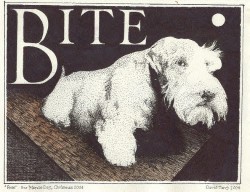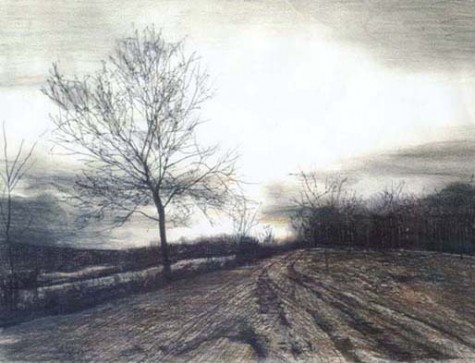Theme Essay by Elizabeth Langosy
Why Editors Can’t Stop Fiddling with Your Story
It’s happened more often than I care to admit.
I write what seems to me to be a brilliant short story or essay—the best ever!—only to be kindly informed by an editor or colleague that “it’s not quite finished.” Or, worse yet, I’m told, “Nice start! You’re halfway there!”
 When I get a response like this, I feel like giving up. I despair over my failure to turn out a polished piece, even after multiple revisions. I mourn the time and effort I put into producing something that requires yet more time and effort.
When I get a response like this, I feel like giving up. I despair over my failure to turn out a polished piece, even after multiple revisions. I mourn the time and effort I put into producing something that requires yet more time and effort.
As a writer, I understand why authors send off manuscripts fully convinced that they're the best they can be. But from my perch as TW's executive editor, I know those stories and essays are rarely finished—and often require the kind of full-out revision no author (including me) likes to confront.
Sometimes a work in progress takes on what I call "the glaze of finality," especially when Word has done its magic and made a rough draft look like a published piece. At a certain point, it's impossible to see past the shiny gloss. Other times, writers get so close to a character or premise that they don’t notice they’re mentally filling in gaps that will later plunge readers into confusion.
Assigning Stories: The Editor's Gamble
Writers and editors can disagree about the status of a piece for many reasons. Occasionally, it's due to poor communication or a personality clash. But most of the time, it's because editors are working for magazines that have specific audiences and points of view. They know what their readers expect to see.
At TW, the pieces we publish come to us through two channels: work we assign to writers and work that arrives unsolicited in our mailbox. When we accept an unsolicited piece, it’s usually well crafted and appropriate for our readers. In most cases, these stories need little editing before they’re considered final, although sometimes we work extensively with an author to bring out the full potential of a remarkable piece.
When we assign a story, we’ve already decided the author would do a great job with a certain topic. But we also want writers to expand on ideas in imaginative ways, taking the original concepts to new places. So we wait to see what an author comes up with. Sometimes we're pleasantly surprised—thrilled, in fact. A story gamble that pays off on the first round is a beautiful thing.
It's also a rare thing. Any experienced editor is used to writers (especially feature writers) making a hash of it at first. If it's a long feature with a complicated premise, it's even more likely the first draft will need lots of editing.
That’s what magazine editors are for—not for yelling "You blew it! Goodbye!" When we assign a story, we expect to help writers develop an idea. We call out faulty assumptions, unclear explanations, and premises that don't work. We make a lot of suggestions.
Writers often misunderstand this kind of gatekeeping, assuming that once they get through the initial gate—acceptance of a manuscript or a story assignment—there are no more hurdles to be jumped. But gatekeeping at the conceptual and line-editing levels is what makes magazine articles appear so clean and cohesive.
Fixing Broken Drafts: Four Examples
I'm one of the editors at TW who often gives authors bad news—exactly the kind of "It's almost there, but..." commentary I've found so hard to swallow for my own work. Although I always end up taking my medicine, I know very well how easy it is to go astray when lost in the fever of writing.
As a longtime editor, I've not only seen every mistake—including a government proposal that slipped past the Spellchecker with “pubic” taking the place of “public”—I've also seen authors do amazing turnarounds with problem manuscripts.
TW editors are also writers, and our theme and story ideas are usually sparked by the things we find personally interesting. Take the following hypothetical theme, based on one of my own quirks.
I have a writing talisman on my desk, a tiny rubbery figure with chartreuse skin, slightly crossed blue eyes, and wings more suitable to an insect than a bird. I know my little sprite is constantly blessing my daily tussles with words. Let's say I decide to assign a few stories about the objects authors rely on to bring them luck or keep them grounded.
Here’s what comes back from four fictitious writers—and how I, as editor, nudge each author "type" in the right direction.
The Academic: "Who Cares About My Personal Experience?"
An author who frequently publishes in academic journals submits a piece that begins with a quote from Jay McInerney on the ancient hand axe given to him by a friend. The essay continues with a carefully researched analysis of the role of talismans in the lives of ten famous authors. The draft is 7,000 words long.
The piece was supposed to be no longer than 1,200 words. More important, TW is all about how we writers respond personally to a topic.
When she sees my edit, this author is surprised to discover I've broken academic protocol by moving her final paragraph up to the beginning and cutting almost all the material about other writers. And she's most flummoxed by my request for information about her own writing talisman.
She does have one, doesn’t she? Well...yes. It's a small oval stone with "courage" written on it in both English and Chinese characters—but why would anybody want to know about that? It doesn't prove anything.
I gently persuade her not only to mention the stone but to layer on details about what it looks like, where it came from, the role it plays in her writing life—and why it might have inspired her to focus on Jay McInerney's prehistoric hand axe at the start of her piece.
This becomes the heart of her story. And I let her footnote some of the material I cut.
The Fiction Writer: "Connect the Dots? What Dots?"
Another author who usually writes fiction wants to take on the theme essay because he loves the beat-up toy piglet that sits on his desk. His first draft begins with a fascinating description of that curly-tailed piglet—its soft, luminous eyes and how it looks almost alive in the moonlight, ready to grant magical powers.
But by the second page, the piglet is completely out of the picture. The story zigzags into how his father always hated the piglet and in fact was really mean to him as a child, and that’s why he ran away from home at fifteen and turned to the life of a street performer in 1960s Haight Ashbury.
This author became so involved in his youthful trauma that he forgot about his opening premise. He needs to reframe the story himself, before I even get into suggesting cuts or other line edits. I prompt him to write a new draft by asking a series of questions.
That's such a moving story, I say. But what happened to the piglet? Did it come along to San Francisco, and, if not, why not? Did you give up on writing at that point? When did you start again? When did you reconnect with the piglet? What does it all mean to you?
The Journalist: "I Don't Really Play with Toys"
My third writer is a highly experienced author of essays, magazine articles, and opinion pieces. He provides a well-reasoned essay about writing talismans, including the miniature lead soldiers that belonged to his grandfather. This author writes that he often takes these out and arranges them into elaborate battle scenes when he gets stuck on an article.
Which, I decide, must have happened while he was working on this draft, because in the middle of it he suddenly seems embarrassed. Self-deprecating sentences appear about how childish it is to play with toy soldiers at his age, how he never shows them to anyone, how the whole idea of good-luck charms is somewhat ridiculous.
Then I step in and reassure him that it’s fine to have a writing talisman (or a whole army of them). I delete all the problem sentences, explaining that they diminish the power of an otherwise fine essay.
The Blogger: “But Everyone Else Liked It the Way It Was”
I've also requested permission to republish a post about a blogger's own good-luck charm—a mug in the shape of a rhinoceros. This post, by a young author who’s new to TW, has received many thoughtful comments and is a great match for the talisman theme.
The blogger happily agrees, even after hearing me mention "a few edits." However, with blog posts, the glaze of finality casts an especially heavy spell. It can make it nearly impossible for an author to approach editing objectively.
Blog posts, which usually haven’t been reviewed by anyone but the author prior to publication, can have the same problems as any other written piece. Readers are forgiving of style or language issues in blogs because they understand the writer is sharing raw thoughts or emotions. But when they read the same post in the guise of a magazine article, they’re less forgiving. Magazines aren't supposed to contain misplaced commas or unclear language or too many “OMG”s and “Wow!!!”s.
I love this blogger's description of her rhinoceros mug—handmade ceramic, with the beast’s projecting head (complete with massive tusks) forming the handle—and how it fits into the world of writers' talismans. But I have to step back from the prodigious string of admiring comments. I push her to fix the confusing gaps in the piece and to write a new ending that meets the promise of the terrific opening.
Final Proofs: It's Still Not Done??
Although at times it may not seem possible, every piece I edit works its way to our production editor, where it’s formatted for publication. Up to this point, it has been just the author and me, honing and refining until at last the article is considered finished.
Yet, I’ve rarely looked at the final proof of a TW piece without making more changes.
 When I see the formatted piece, ready to go out to the world, a few lingering problems with clarity or consistency usually jump out. At this stage, I know the author’s story and intent well enough that I can easily fix them myself.
When I see the formatted piece, ready to go out to the world, a few lingering problems with clarity or consistency usually jump out. At this stage, I know the author’s story and intent well enough that I can easily fix them myself.
But when an author sees the proof, it can trigger any number of reactions. Viewing the formatted proof can lead a writer to think everything is perfect because it looks "real." Or the proof might make the author realize, maybe for the first time, that her thoughts and opinions are about to go public. Then I’ll get some panicked word changes or clarifications.
Other TW editors may also weigh in with suggested changes at this stage. Darn them.
Eventually, we need to put the project to bed and move on to the next one—a tough task for perfectionists who spend their lives analyzing sentence flow. Nothing for it, then, but to rely on the glaze of finality—which isn't always bad.
Art Information
- “Horn Quarter, Virginia. 1829″ © David Terry; used by permission
- “Bolivar Road” © David Terry; used by permission
- “Bite (Sealyham Terrier, Charlottesville VA)” © David Terry ; used by permission
 Elizabeth Langosy is the executive editor of Talking Writing. The photo shows her with her talisman during a late-night writing session.
Elizabeth Langosy is the executive editor of Talking Writing. The photo shows her with her talisman during a late-night writing session.
This essay was edited by Martha Nichols, whose guiding hand—even from the other side of the world —went so far as to inspire a midway shift in topic. After being told “It’s not quite finished” for a goodly number of days, Elizabeth finally received an exhilarating “By George, you’ve got it!”
“'Writing one true sentence' is very different from 'rendering things into language,' which implies a complex assessment of the options. Yet, the idea of beginning from a point of known reality—whether of place, feeling, or character—makes enormous sense to me.” —A.S. Byatt's Plums

